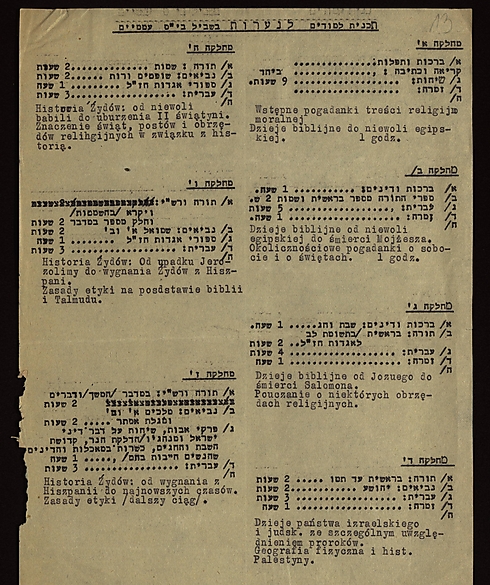Timetable for the children of the holocaust reveals ‘intense fears’ but also determination to maintain Jewish culture despite Nazi threat.
The Shem Olam institute recently managed to find the schedule of a Jewish school in Poland from 1941, when students had already begun being sent to forced labor camps.
Community leaders didn’t know whether authorities would approve the school’s opening at that point, as uncertainty over the fate of Jews was increasing more and more. But that didn’t prevent them from worrying about the students’ connection to their religious and national roots.
Nearly half of the learning hours in the Krakow ghetto at the time were dedicated to the following subjects: In first grade, pupils learned religious blessings, prayers, and torah stories (as well as songs).
Second graders studied Genesis and talk of the Shabbat and holidays; in third grade religious statutes and prophets were added; and in fourth grade pupils studies the interpretations of Rashi (Rabbi Shlomo Yitzchaki), the book of Ruth and physical and historical geographies of the land of Israel.
The fifth graders, both secular and religious, studied the book of Leviticus, Mishna and Jewish history, Babylonian scrolls and the destruction of the second temple.
The sixth graders studied the book of Numbers, Deuteronomy and Kings, and historical events from the fall of Jerusalem to the Spanish inquisition.

The seventh graders studied Gmara, Pirkei Avot, and the laws of tefilin and Shabbat.
Alongside Jewish learning, the students studied the general disciplines of math, geography, nature, and Polish language. The three most popular classes were nature, Polish, and Jewish studies.
An additional document that was found, “Shem Olam,” featuring a letter sent to the Jewish Council in Lublin on 29.01.41, by the heads of Krakow’s Jewish community. In the letter, the heads of Krakow’s Jewish community express their concerns regarding the opening of the school year.
The leaders admit that due to differences of opinion among parents, they recommend opening at least three general study tracks, with the main difference between the tracks being the amount of hours set aside for Jewish studies, ranging from 10-18 hours a week.
Rabbi Abraham Krieger, head of “Shem Olam” institute, reacted to the finds saying, “The new documents expose the intense fears within the Polish Jewish community that the school year wouldn’t begin as planned, due to the ongoing existential threat during that dark period.”
“On the other hand, we see their desire to maintain a central Jewish studies curriculum in an apparent attempt to strengthen their Jewish heritage at a time when its very existence was at stake,” he concluded.
Krakow’s Jewish community, once a central and influential element of European Jewry, was completely obliterated during the Holocaust. The Nazi’s and their helpers killed 60,000 of the city’s Jews, who represented one fifth of the city’s citizens before the war.
As reported by Ynetnews
